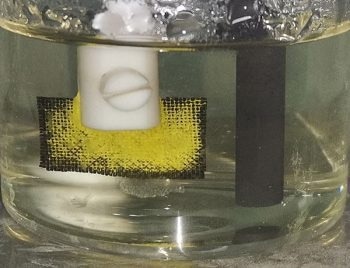Most of Earth’s surface is made up of oceans, home to an astounding variety of living forms and a diluted population of uranium ions. Furthermore, these specific ions could provide a sustainable fuel supply for nuclear power plants if we can extract them from the water.
 This new coated cloth effectively accumulated uranium (in yellow) on its surface from uranium-spiked seawater. Image Credit: ACS Central Science, 2023, DOI: 10.1021/acscentsci.3c01291
This new coated cloth effectively accumulated uranium (in yellow) on its surface from uranium-spiked seawater. Image Credit: ACS Central Science, 2023, DOI: 10.1021/acscentsci.3c01291
Scientists have now created a material that can be used with electrochemical extraction to draw hard-to-get uranium ions from saltwater than current techniques. Their findings are published in ACS Central Science.
Nuclear power reactors use fission to essentially split apart atoms to unleash the energy that is naturally trapped inside them and convert it into heat and electricity. Since uranium can split easily due to its radioactivity and instability in all forms, it has emerged as the element of choice for this operation.
At the moment, this metal is taken from rocks; nevertheless, the supplies of uranium ore are limited. However, 4.5 billion tons of uranium are thought to be floating about in the oceans as dissolved uranyl ions, according to estimations from the Nuclear Energy Agency.
The reserve exceeds the land area by a factor of 1,000. However, the materials used to extract these ions do not have enough surface area to efficiently trap ions, making the process difficult. To facilitate the electrochemical extraction of uranium ions from seawater, Rui Zhao, Guangshan Zhu, and associates set out to create an electrode material that had a large number of tiny nooks and crannies.
The group started using a flexible cloth made of carbon fibers to make their electrodes. Two specific monomers were applied to the fabric and subsequently polymerized. They then applied hydroxylamine hydrochloride to the fabric to provide the polymers amidoxime groups.
The amidoxime was able to nestle in several tiny pockets made by the cloth’s naturally porous structure, which made it easy to capture the uranyl ions. In test runs, the scientists inserted a graphite anode, a cyclic current between the electrodes, and the coated cloth as a cathode in either naturally occurring or seawater tainted with uranium. Precipitates containing uranium that were brilliant yellow were collected over time on the cathode cloth.
During the course of 24 days, the electrodes in the experiments conducted on seawater gathered from the Bohai Sea retrieved 12.6 milligrams of uranium per gram of water. The capability of the coated material was greater than that of the majority of the other uranium-extracting materials the researchers had examined.
Furthermore, trapping the ions with electrochemistry was around three times faster than letting them build up on the fabrics naturally. According to the researchers, this study provides a practical way to extract uranium from seawater, which could enable oceans to become new sources of nuclear fuel.
The authors gratefully acknowledge funding from the National Key R&D Program of China, the National Natural Science Foundation of China, the Project of Jilin Province’s Education Department, the Natural Science Foundation of Jilin Province's Department of Science and Technology, the Fundamental Research Funds for Central Universities, and the “111” project.
Journal Reference:
Chen, D., et. al. (2023) Self-Standing Porous Aromatic Framework Electrodes for Efficient Electrochemical Uranium Extraction. ACS Central Science. doi:10.1021/acscentsci.3c01291